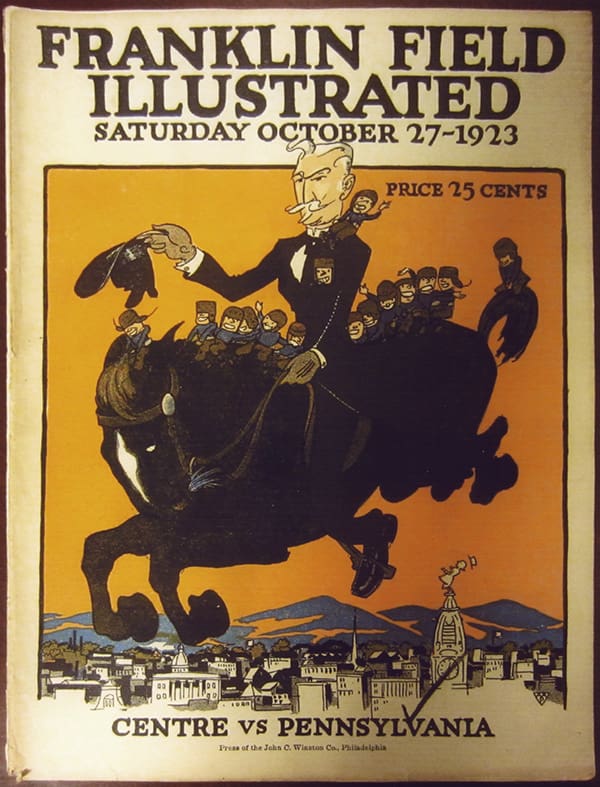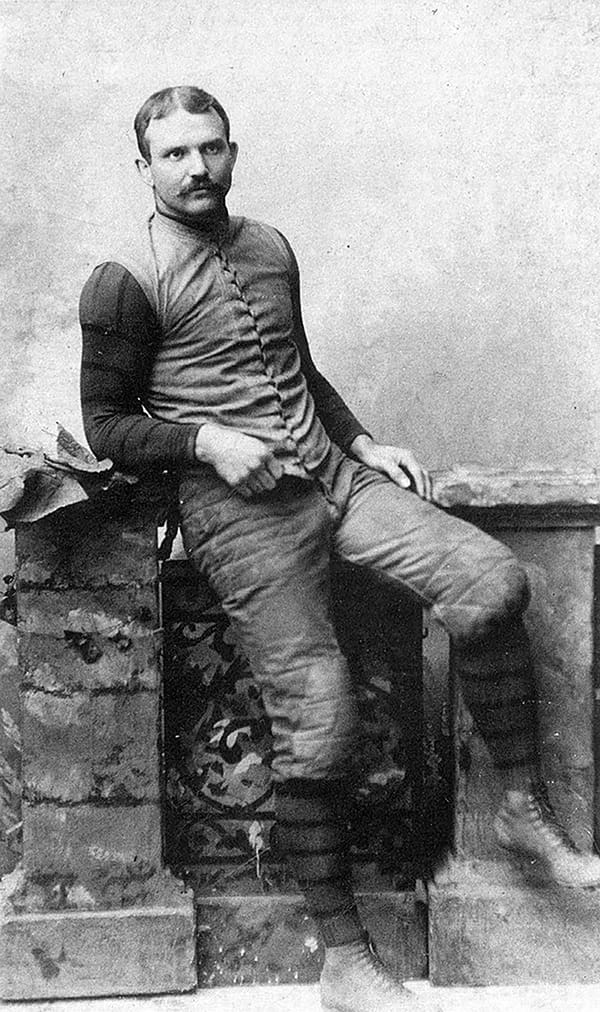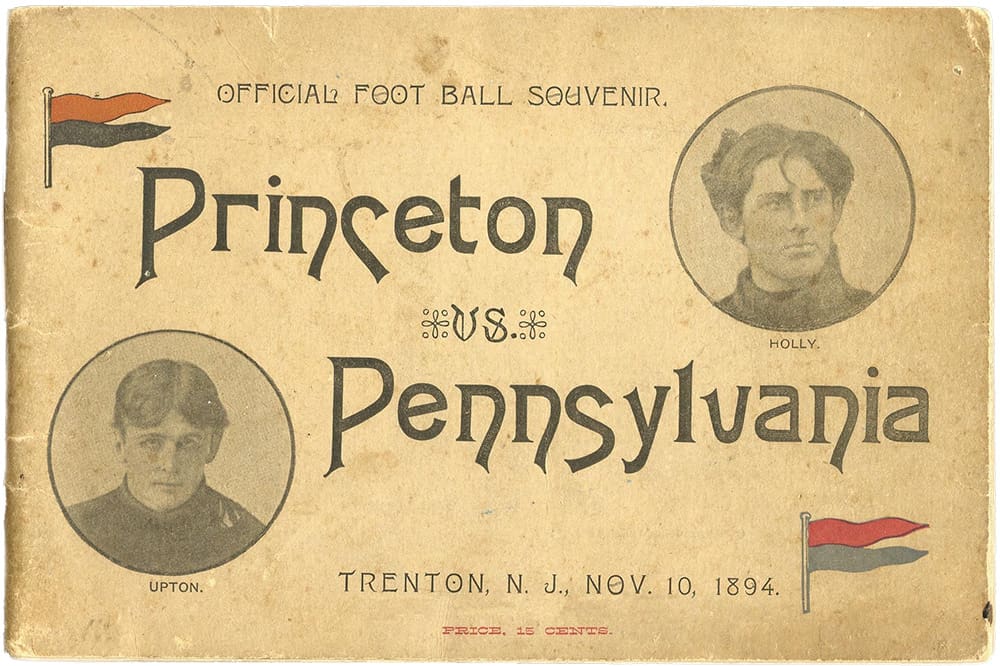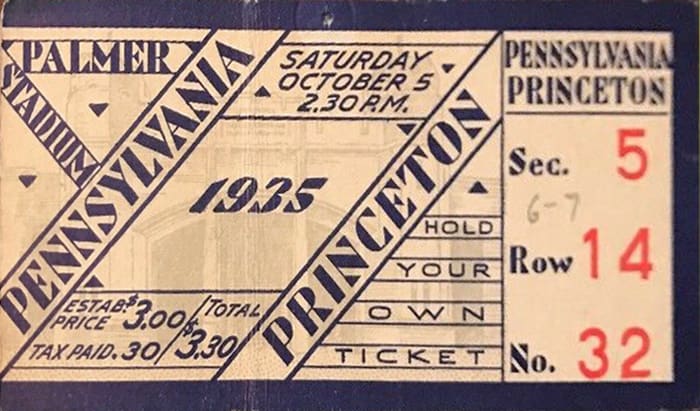October 27, 1923 Centre- The University of Pennsylvania

The University of Pennsylvania was a major football power for many decades until choosing to deemphasize the sport in the mid-1950's. Just as it is sometimes hard to reconcile the present, modern day programs of the "Big 3," Harvard, Yale and Princeton, with their dominance of college football in the first 50 years of the sport, so it is with the Penn Quakers.
Pennsylvania began playing intercollegiate football in the Centennial year of 1876 on an informal basis. The first game was on November 1 and the result was a 6-0 loss to Princeton. From that first season until 1885, the students played without a coach and won 20, lost 20, and tied 3. Of those 43 contests, 11 were with the Princeton, and Penn lost every time it took the field against the Tigers.
This wasn't acceptable, so Penn got serious enough about the sport to hire its first coach, Frank Dole, for the 1885 season. Dole did fairly well, compiling a 23-19-1 record in 3 seasons. During Dole's tenure, Penn played up to 17 games a season, competing 3 times each year against Princeton. Even though Dole had some overall success, his teams continued to lose to Princeton, coming up short 9 times.
That made it 0-20 against the Tigers from New Jersey, located just 40 miles away.
In 1888, E.O. Wagenhurst took over the coaching duties and had a respectable 38-18 record in his 4 seasons at the helm. However, he was 0-7 against Princeton, and now Penn had lost 27 straight times to its chief rival. The overall points scored in the series found Princeton having run up an embarrassingly decisive margin, 867-46, for an average rounded off score of 32-2.
Something had to be done!
In 1892, George Woodruff, a 28-year old former all-around athlete at Yale, took over the Penn football program.

George Woodruff during his days at Yale
Woodruff had a knack for coming up with innovative, unexpected offensive plays, and his arrival began a golden era for Quaker football.
Woodruff's 1892 team compiled a 15-1 record, losing only to Yale in a game played in New York City. Importantly, Penn beat Princeton for the first time, winning 6-4.
In 1893, Princeton edged the Quakers 4-0. The overall record for Penn that year was 12-3, with the other two losses being to Yale and Harvard.
1894 was the decisive year in the Penn-Princeton rivalry. Woodruff had been perfecting a unique offensive scheme and saving it just for the Princeton game. The boys from Pennsylvania went to Trenton, New Jersey, where the game was to be played on November 10, sporting a perfect 9-0 record. Princeton was 7-0. 12,000 ardent fans turned out to see the battle between the two undefeated teams.

Program for the historic 1894 game
For the first time, Coach Woodruff unveiled his carefully kept secret, the "guards back" offense.

Penn's Coach Woodruff from 1892-1901
The Penn quarterback, Carl Williams, would call out "guards right!" or "guards left!" The two guards would drop back to either the right or left side of their quarterback, giving the Quakers 2 extra men to run interference. The play would usually be run toward the side the guards had lined up on, but to keep the defense honest, sometimes it would go in the opposite direction. Princeton simply couldn't adjust to the new offensive formation and remained befuddled all afternoon.
Penn won, 12-0.

Penn's 1894 undefeated team which went 12-0 with 4 All-Americans. The Quakers not only beat Princeton but also Harvard and were determined to be the National Champions. Coach Woodruff is in the middle of the 3rd row with a tie.
Philadelphia was the home not only of the University of Pennsylvania, but a great number of the Princeton alumni also lived in the perhaps misnamed, "City of Brotherly Love." Mayhem broke out after the game as the Princetonians returned to their homes in Philadelphia on the train and the accompanying Penn alumni and students began to harass them as they all traveled. The jeering and what had been good natured razzing got somewhat ugly when a large number of Penn partisans met the train as it arrived, cheering and singing songs, and then began to get rowdy while streaming away from the terminal and into the streets.
A quick-witted Penn fan wrote a song which was passed out to the revelers and used to taunt the Tigers' supporters.
OH MY! OH MY!
HOW WE BLACKED THE TIGERS' EYE.
WHAT'VE YOU DONE? WHAT'VE YOU DONE?
BEAT THE TIGERS TWELVE TO NONE.
HOW DID YOU DO IT? HOW DID YOU DO IT?
EASY! EASY!
WHAT'S THE SCORE? THREE TIMES FOUR.
PRINCETON'S TIGERS ON THE FLOOR!
The celebrations continued on into the evening. A theatre performance was interrupted. Wannamaker's Department Store became the scene of some "unpleasantness" as the crowd raced through "knocking female shoppers to and fro."
A few days after the 1894 game, the Princeton faculty convened and voted to suspend future athletic contests with Penn. Not to be outdone, the Penn faculty decided to meet and voted similarly, prohibiting any contact with Princeton's teams. The two esteemed universities later decided to soften their stances and allowed competition in the "minor sports."
Each school waited for the other to call, but it was over 40 years before the Pennsylvania Quakers and Princeton Tigers met again on the gridiron! Finally, in 1935, there was a truce- "Old boy, tell me now, why is it that we are upset with each other?"- and Princeton beat Penn, 7-6, on October 5 at Princeton's Palmer Stadium in front of 50,000 fans, and the two institutions have played most years since.

The first game in over 40 years
From the arrival of Gene Woodruff in 1892 until the October 27, 1923 game with Centre, Penn had won 284, lost 68, and tied 18. Excluding ties, the Quakers had won 80.7% of their games, quite a remarkable record, especially considering that the Philadelphia school played a top-tier schedule.
Teams like Yale, Harvard, Penn State, Michigan, Cornell, Pittsburgh, Alabama, Army, Navy, West Virginia, Dartmouth, Brown, Carlisle, Georgia Tech, along with the University of Chicago and Washington and Jefferson, both powers at the time, appeared frequently in the line-up of programs which the Quakers took on.
In 1922, interest in the Penn football team had reached such a level that the athletic council oversaw the building of a magnificent new Franklin Field which replaced the old wooden stadium of the same name. It held 54,500, nearly doubling the original stadium, and the first game was held in the new facility on September 30, 1922, a 14-0 win over Franklin and Marshall.

The new Franklin Field, opened the year before the Centre game
Even 54,500 seats weren't enough, and in 1925, a second deck was added, bringing the capacity to slightly over 78,000.
Penn played all 9 of its games at the new Franklin Field in 1922, going 6-3. The schedule for 1923 was again to have all games at home.
( Penn played 28 straight home games from 1922-24 before traveling to play California in a post-season game on January 1, 1925, which they lost, 14-0. This was not the Rose Bowl but a game at California's Memorial Stadium in Berkeley. )
Centre found Penn to be an excellent fit for its 1923 campaign. While the Quakers weren't one of the "Big 3," if they weren't equal, they were certainly very close. They were from the East, they had a significant following, they had a wonderful new stadium, and perhaps most importantly, a game with Penn would generate an enormous amount of press, and recognition was at the root of what Centre had sought when Dr. Ganfield had originally decided to promote football as a way to put Centre on the map, and keep it there.
During the last few years, the newspapers along the East Coast had provided more publicity for Centre than any advertising agency could have generated with a million dollar budget. The stories flowing out of the Boston and New York metropolitan areas and the news syndicates had been picked up, published, and read all across the country.
In big cities, small towns, and rural areas, the question asked each Sunday morning during football season as the local newspapers were being read was, "What did Centre do yesterday?"
Centre was "in." Centre was the perfect story- the little school which had become hugely successful, but retained an innocence despite its fame. Centre was determined to remain in the public's eye, and that's why the Colonels were at Danville's Southern Station at 5:30 P.M. on Wednesday, October 24, 1923, getting ready to board their specially chartered Pullman for the long ride to Philadelphia.
Waiting on a siding to connect to the regularly scheduled New Orleans- Cincinnati #42, northbound train, was another Pullman to carry the Centre fans to the game. The fare for an upper berth was $72.00 and a lower, $72.50, for the roundtrip, obviously not much of a differential. The Pullman Company had agreed to leave the car in the yard at Philadelphia's Broad Street Station until the return trip Saturday night so that the fans could use their berth for sleep in lieu of a hotel if they wished.
Centre was taking 28 players to the game, 12 backs and 16 linemen. The Pullman was a 16 section sleeper, and in addition to the players, the Chief, Uncle Charlie, and assistant coaches Ben Cregor and Jim Kendrick were going. The other Pullman had berths for student manager, Elliott McDowell, assistant manager, Brown Young Willis, Jr., student trainer, H. Miller, the "rubber," or masseur, Dudley Doneghy, and Dr. Allen, chairman of the athletic department. It was a far cry from the small numbers who made the trip to Charleston, West Virginia just 4 years before.
There was one more important person going along, not to perform at the half, but to assist on the sidelines with the water bucket. Jop reported on the scene about the departure.
Roscoe Conklin Breckinridge, the cake walker, masseur and songster, who follows the team wherever it goes, was at the station far before the time for departure. For fear that someone may mistake his identity, Roscoe toted a large, black leather suitcase. Gaily painted in gold and white on one side was "Roscoe." On the other side, "Centre."
Several hundred people were at the station for the send-off. The rallying cry was, "Go to town, Colonels!" As the team was boarding, Jop continued his reporting from the station about on an incident which occurred just before the train pulled out.
An old man, a Civil War veteran, his hair snow-white, and his gait unsteady, edged through the crowd and called for Captain Kubale. Taking the Centre chieftain by the arm, he walked a few feet down the platform and pointed to a sign painted on a mill just across the tracks.
"Read, son," he told Kubale.
"Centre 6- Harvard 0. We gave 'em Hell," read the sign. Kubale then pressed the old man's hand and in a choked voice muttered, "We'll battle them," and was on his way.
Kubale understood, and he recounted the incident to his teammates as the train steamed out of Danville.
The Colonels and fans were hauled to Cincinnati by the Southern, and disconnected there to be joined to a Pennsylvania Railroad passenger train heading east. The railroad's main east-west line would be met at the Xenia, Ohio junction, and from there the route would be due east across Ohio and then Pennsylvania, with arrival at the Pennsylvania's Broad Street Station at 5:00 P.M. Thursday, nearly 24 hours after leaving Danville.
Unlike the last trip to the East, the 1922 "misadventure" to Harvard, the journey to Philadelphia went off without a hitch. The scheduled arrival time was met, and the team was in its hotel, the Rittenhouse at 2126 Chestnut Street, in time to have dinner and still have a couple of hours of leisure in the evening to stroll around historic, Rittenhouse Square, led by a guide supplied by the local Centre alumni.
Once again, the Colonels were fulfilling the Chief"s goal of having the team's travels serve as a broadening educational experience for "his boys."
On Friday, a practice was held 11 miles southwest of Centre's hotel at Swarthmore College. Frank Pitts, one of Swarthmore's assistant coaches, had played for the Tulane team that Centre beat in New Orleans on Thanksgiving, 1921. Fitts had kept in contact with some of the Colonels, in particular, Minos Gordy, who was from Abbeville, Louisiana, and had written Centre prior to the departure for Philadelphia offering the school's facility.
The practice was closed to the public because Uncle Charlie had incorporated some new plays into the Colonels' offense which hadn't been shown, or needed, during the first 3 games. The team was driven to Swarthmore by Centre alumni and friends of the college who lived in Philadelphia. It seemed that wherever Centre traveled, there were always people who were literally waiting in line to help in any way they could, and the Philadelphia experience was no different than all of the others.
Friday night, the University of Kentucky alumni of Philadelphia joined with Centre's alumni to host a dinner and reception at the elegant Bellevue-Stratford Hotel in the City Center.

Comment was made by the UK alumni that when Centre and Kentucky play, "Naturally, we are for our alma mater. But we are Kentuckians, and the rivalry disappears when Centre is playing anybody else. We toast our fellow Kentuckians, and hope you have a great victory at Franklin Field tomorrow."
Hip, Hip, Hooray!
Hip, Hip, Hooray!
Three cheers for Centre,
Hip, Hip, Hooray!
The University of Pennsylvania had been promoting the Centre game for several weeks by placing signs on the Philadelphia buses. The ticket sales had been strong since the initial announcement that the game had been scheduled, and it appeared that the Colonels would draw the biggest crowd yet for the 1923 Penn season.
The Quakers were guided by a new coach, Lou Young, who remained at the university for 7 years, compiling 49-15-2 record before retiring after the 1929 season, and were 3-1 with the following record and attendance;
Penn 20 Franklin and Marshall 0 31,000
Penn 0 Maryland 3 38,000
Penn 13 Swarthmore 10 35,000
Penn 19 Columbia 7 38,000
While the attendance figures for the first 4 games were quite respectable, the fact is that the totals were swelled somewhat by the proximity of Penn's opponents to Philadelphia, allowing fans of the visiting teams to attend with relative ease. Franklin and Marshall was 80 miles west in Lancaster, Pennsylvania. Maryland and Columbia were each approximately 100 miles away, and Swarthmore was a suburb of the city.
Centre's alumni and fans could fill a few seats at Franklin Field, but nearly all of the 42,000 who attended the game were there not only to support Penn, but also to see the famous Colonels, this group of young men who had beaten Harvard. After the game, the officials at Penn stated they were extremely pleased with the numbers when the final tally was released.
Centre outplayed Penn in the 1st quarter, moving the ball well and twice getting within field goal range, even if the attempts were at the upper limits of Herb Covington's range. Covey missed both tries, and the quarter ended scoreless.
The 2nd period was more of the same, a defensive struggle characterized by hard hitting and great play by both teams. Toward the end of the quarter, Centre looked like it was going to gain good field position and possibly move into range for another field goal effort as the Quakers had 4th down on their own 23. However, Penn's left halfback, Ernest Hamer, got off a booming kick with a significant roll which put the Colonels back on their own 20. A series of runs and penalties ended up with the Colonels losing 15 yards in 3 plays, and Albert Spurlock had to punt while standing deep in his end zone.
Spurlock did a nice job getting the ball fairly deep, and Penn brought it back to the Centre 35 as the clock was running down. The Quakers ran several off-tackle thrusts and moved it to the 11. Just as time was about to expire, Penn sent in its field goal kicker, Hugh King, who was good from the 22, and the half ended with Penn up, 3-0.
Jop reported that Centre had more than held its own during the 1st half. But he said when the two teams went to their dressing rooms, he felt he was watching a replay of the 1920 Harvard game in which the score had been 14-14 at the break, but Harvard had seemed to be gaining the upper hand as the half wound down.
The Colonels looked like they were getting beaten by the heavier Penn front wall, and toward the end of the 2nd quarter, the Quakers were beginning to control the line of scrimmage, just as Harvard had in 1920. Also, it appeared that Penn totally anticipated any new formation or play that Uncle Charlie had inserted into the attack. The players and coaches later said that "it seemed like they had learned about our plays in advance," because Penn was always ready and shifted into effective defensive formations which were able to bottle up Centre's efforts.
Were there "eyes" at Swarthmore when Centre held its "secret" practice? No one ever made that accusation, but there were suspicions.
The 2nd half was all Penn. A pass from Rea McGraw to John Dern resulted in a 3rd quarter touchdown, and the extra point made it 10-0 at the end of the 3rd quarter.
Early in the 4th quarter, Ernest Hamer scored, the point after was good, and Penn led, 17-0.

Penn's Ernest Hamer who had a TD and two extra points
Penn's big fullback, E. A. Thomas, plowed into the end zone near the end of the game, and the P.A.T. made it 24-0 when time expired.

There were no excuses offered by Centre. Uncle Charlie told the press in interviews after the game that the Quakers had the better team that afternoon. Centre's most ardent supporter, George Joplin, said the same, then added that he didn't think Penn was 24 points superior, "but more like 10."
The night after the game, there was another affair at the Bellevue-Stratford, a dinner dance, attended by the coaches and players for both teams, this time hosted by Penn.
Jop wrote that it was a delightful affair, and that Centre had been treated wonderfully during its stay in Philadelphia. The team and fans got to their Pullmans late Saturday night for the long ride back home. It had been a loss, but it had also been a great experience for the young men from Danville.
Despite not returning with a victory, there was a large crowd waiting at the stadium, even at the late arrival time. Many felt that they had actually been at the game, as they had "watched" it on the "Grid-Graph" which everyone deemed a great success.
